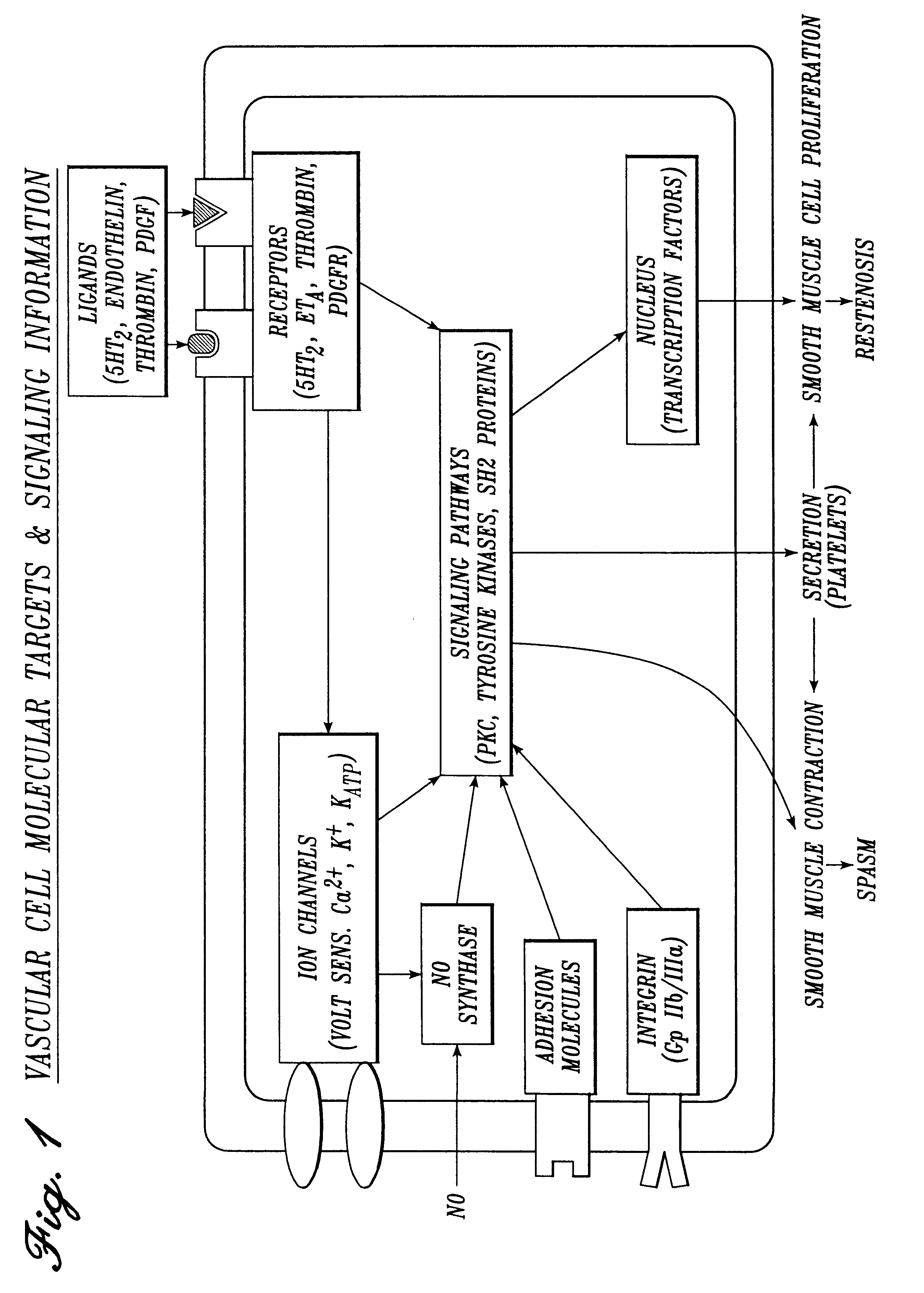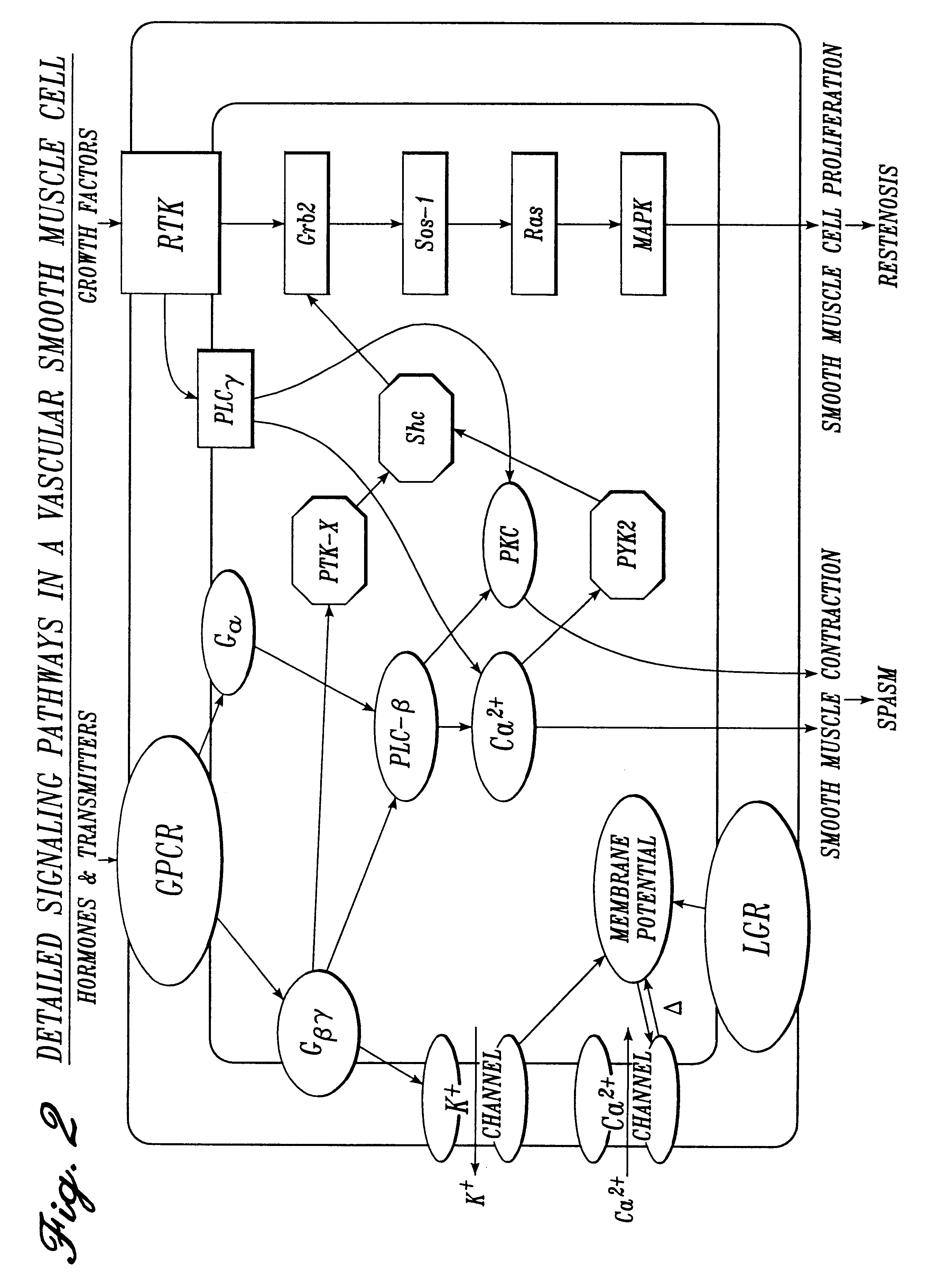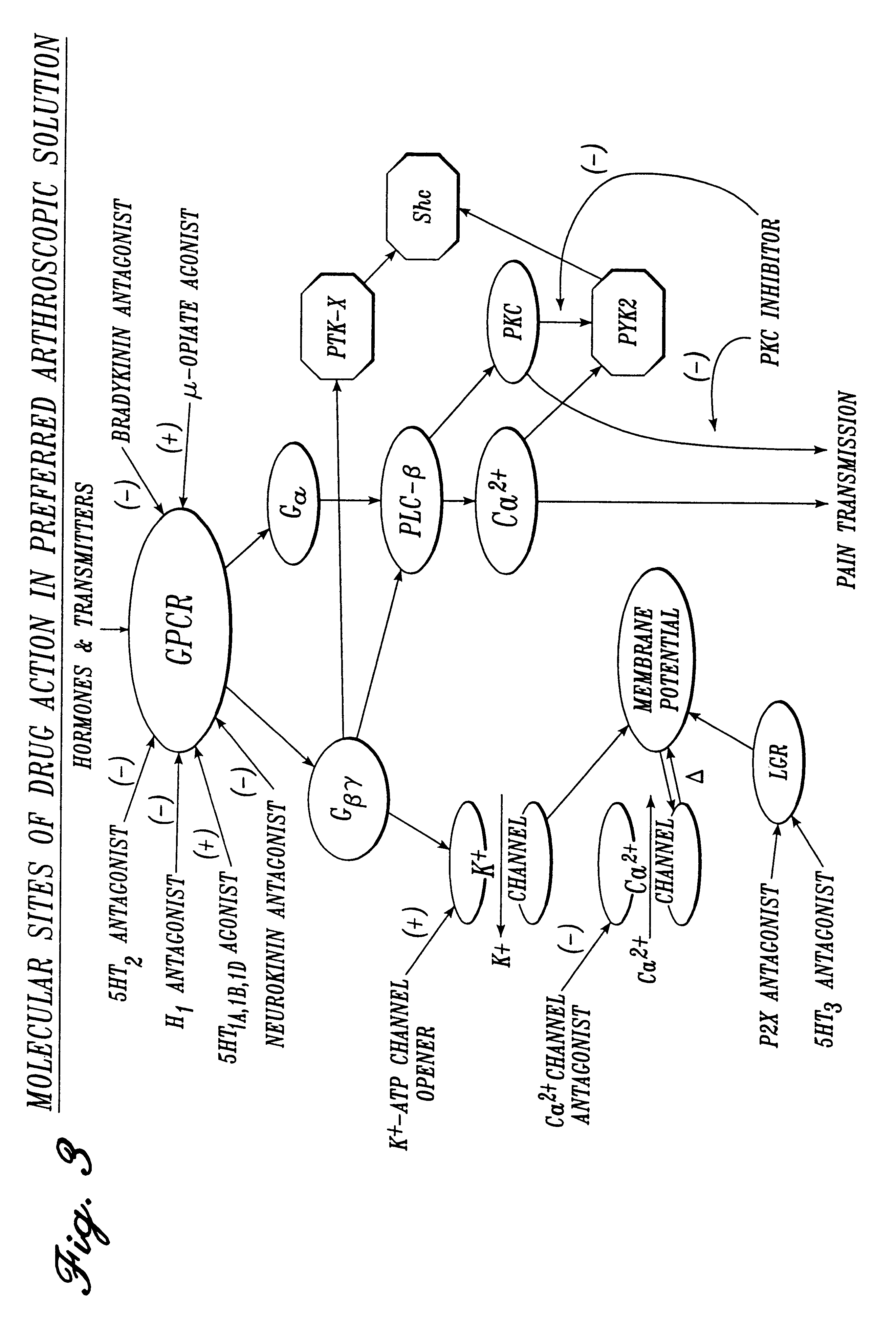A significant
advantage of the invention is derived from the
rapid onset of
pharmacological action. Direct, local delivery of the anti-tumor adhesion agents initiated at the outset of the surgical procedure and continued during the surgical procedure (i.e., perioperatively) has the potential to inhibit one of the earliest steps of
metastasis, the initial
adhesion process. The immediate and constant delivery of therapeutically effective concentrations of anti-adhesion and / or invasion agents is expected to preemptively inhibit the initial attachment of
tumor cells to both the
extracellular matrix and other cells and subsequent invasion into these tissues. Studies have found that the highest rate of tumor implantation occurred when
tumor cells were injected immediately after
surgery, indicative of the critical timing for therapeutic inhibition of the
adhesion process.
is derived from the
rapid onset of
pharmacological action. Direct, local delivery of the anti-tumor adhesion agents initiated at the outset of the surgical procedure and continued during the surgical procedure (i.e., perioperatively) has the potential to inhibit one of the earliest steps of metastasis, the initial
adhesion process. The immediate and constant delivery of therapeutically effective concentrations of anti-adhesion and / or invasion agents is expected to preemptively inhibit the initial attachment of
tumor cells to both the
extracellular matrix and other cells and subsequent invasion into these tissues. Studies have found that the highest rate of tumor implantation occurred when tumor cells were injected immediately after
surgery, indicative of the critical timing for therapeutic inhibition of the adhesion process.
The method of delivery and pharmaceutical composition of the present invention provide distinct advantages which include: 1) a
combination drug therapy directed to the multifactorial causes of tumor
cell adhesion / invasion / local metastasis,
inflammation, pain,
smooth muscle spasm and
restenosis during
surgical procedures, 2) local delivery of the
drug combination achieves an instantaneous therapeutic concentration of anti-tumor adhesion agents at the operative site, 3)
continuous delivery of therapeutic agents in an
irrigation solution provides a constant
drug concentration in a therapeutically effective range at the operative site during a surgical procedure, 4) local delivery permits a reduction in total
drug dose and
dosing frequency compared to systemic delivery, and 5) direct, local delivery to the
surgical site enables use of novel, pharmaceutically active agents, such as certain peptides and antibodies, which cannot be delivered systemically.
The present invention further provides a solution constituting a mixture of multiple agents in low concentrations directed at inhibiting locally the mediators of pain, inflammation, spasm and
restenosis in a physiologic
electrolyte carrier fluid. The invention also provides a method for
perioperative delivery of the
irrigation solution containing these agents directly to a
surgical site, where it works locally at the
receptor and
enzyme levels to preemptively limit pain, inflammation, spasm and restenosis at the site. Due to the local
perioperative delivery method of the present invention, a desired
therapeutic effect can be achieved with lower doses of agents than are necessary when employing other methods of delivery (i.e., intravenous, intramuscular, subcutaneous and oral). The anti-pain / anti-inflammation agents in the solution include agents selected from the following classes of receptor antagonists and agonists and
enzyme activators and inhibitors, each class acting through a differing
molecular mechanism of action for pain and inflammation inhibition: (1)
serotonin receptor antagonists; (2)
serotonin receptor agonists; (3)
histamine receptor antagonists; (4)
bradykinin receptor antagonists; (5)
kallikrein inhibitors; (6) tachykinin receptor antagonists, including neurokinin, and neurokinin.sub.2
receptor subtype antagonists; (7)
calcitonin gene-related
peptide (CGRP) receptor antagonists; (8)
interleukin receptor antagonists; (9) inhibitors of enzymes active in the synthetic pathway for
arachidonic acid metabolites, including (a)
phospholipase inhibitors, including PLA.sub.2 isoform inhibitors and PLC.sub..gamma. isoform inhibitors, (b)
cyclooxygenase inhibitors, and (c) lipooxygenase inhibitors; (10)
prostanoid receptor antagonists including eicosanoid EP-1 and EP-4
receptor subtype antagonists and
thromboxane receptor subtype antagonists; (11)
leukotriene receptor antagonists including
leukotriene B.sub.4 receptor subtype antagonists and
leukotriene D.sub.4 receptor subtype antagonists; (12)
opioid receptor agonists, including .mu.-
opioid, .
delta.-
opioid, and .kappa.-
opioid receptor subtype agonists; (13) purinoceptor agonists and antagonists including P.sub.2X receptor antagonists and P.sub.2Y receptor agonists; and (14)
adenosine triphosphate (ATP)-sensitive
potassium channel openers. Each of the above agents functions either as an anti-inflammatory agent and / or as an anti-nociceptive, i.e., anti-pain or
analgesic, agent. The selection of agents from these classes of compounds is tailored for the particular application.
Several preferred embodiments of the solution of the present invention also include anti-spasm agents for particular applications. For example, anti-spasm agents may be included alone or in combination with anti-pain / anti-inflammation agents in solutions used for vascular procedures to limit
vasospasm, and anti-spasm agents may be included for urologic procedures to limit spasm in the urinary tract and bladder wall. For such applications, anti-spasm agents are utilized in the solution. For example, an anti-pain / anti-inflammation agent which also serves as an anti-spasm agent may be included. Suitable anti-inflammatory / anti-pain agents which also act as anti-spasm agents include
serotonin receptor antagonists, tachykinin receptor antagonists, and ATP-sensitive
potassium channel openers. Other agents which may be utilized in the solution specifically for their anti-spasm properties include
calcium channel antagonists, endothelin receptor antagonists and the
nitric oxide donors (
enzyme activators).
Specific preferred embodiments of the solution of the present invention for use in cardiovascular and general vascular procedures include anti-restenosis agents, which most preferably are used in combination with anti-spasm agents. Suitable anti-restenosis agents include: (1) antiplatelet agents including: (a)
thrombin inhibitors and receptor antagonists, (b)
adenosine disphosphate (ADP) receptor antagonists (also known as purinoceptor.sub.1 receptor antagonists), (c)
thromboxane inhibitors and receptor antagonists and (d)
platelet membrane
glycoprotein receptor antagonists; (2) inhibitors of
cell adhesion molecules, including (a)
selectin inhibitors and (b)
integrin inhibitors; (3) anti-chemotactic agents; (4)
interleukin receptor antagonists (which also serve as anti-pain / anti-inflammation agents); and (5)
intracellular signaling inhibitors including: (a)
protein kinase C (PKC) inhibitors and
protein tyrosine kinase inhibitors, (b) modulators of
intracellular protein tyrosine phosphatases, (c) inhibitors of src homology.sub.2 (SH2) domains, and (d)
calcium channel antagonists. Such agents are useful in preventing restenosis of arteries treated by
angioplasty,
rotational atherectomy or other cardiovascular or general vascular therapeutic or diagnostic procedure.
 Login to View More
Login to View More 


